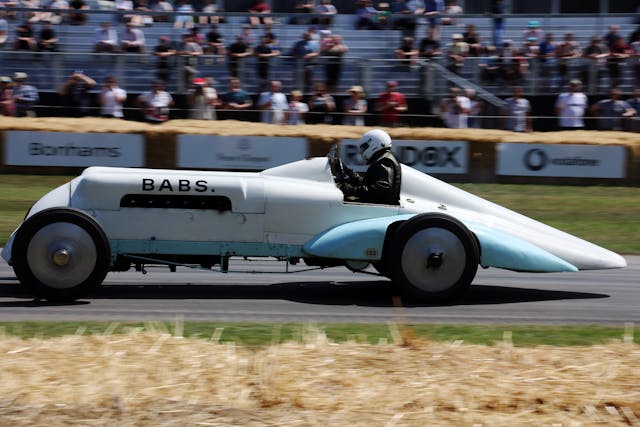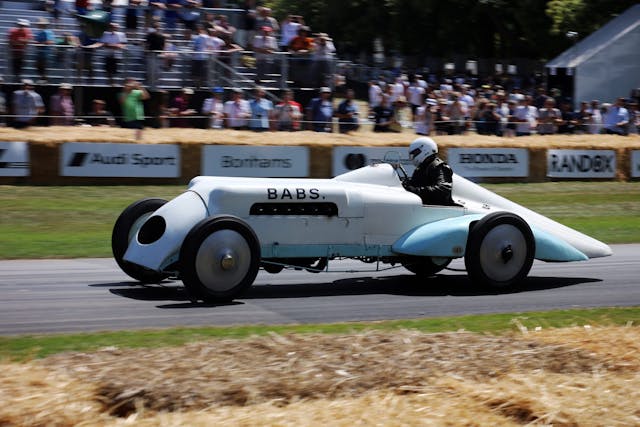Media | Articles
On this Day in 1926: John Perry-Thomas breaks the Land Speed Record with the 171-mph “Babs”
On this day in 1926, John Perry-Thomas set the Land Speed Record at 171.02 mph on the hard-packed beaches of Pendine Sands. Dubbed “Babs” by Perry-Thomas, the streamlined behemoth which he rode atop represents a fleeting tale of triumph as land speed racing pushed the envelope of motorsport technology.
Perry-Thomas had bought himself the deal of his life in 1924 when he bought “Chitty Bang Bang 4” from the late Count Louis Zborowski, himself a pioneering builder. His series of Chitty Bang Bang race cars were his renditions of contemporary Mercedes chassis rebodied with aerodynamic sheetmetal. Power was always the central focus with the Chitty Bang Bangs, with the series featuring aircraft engines with coffee can-sized pistons and displacement figures that are unimaginable today. Though Count Louis later died during its construction, Chitty 4 continued this tradition with an American-built 27-liter Liberty V-12 aircraft engine. The World War I-era surplus engine was known to produce 450 hp with mountains of torque, and this was all fed through a Mercedes chain-drive transmission in Chitty 4. This was his crowning achievement, and it earned the unique title of the “Higham Special” during the final phases of assembly.
Perhaps in a moment of foreshadowing, Count Louis was killed while racing with Mercedes in 1924, and it was in his estate sale that Perry-Thomas came into the picture. He bought Chitty 4 for the sum of £125, approximately £1500 in today’s GBP. The Leyland Motors engineer had been formulating an assault on the land speed record and the rough-cut Chitty 4 offered an unbeatable opportunity for the blue collar engineer.
After finishing the loose ends with a new Leyland-based front suspension and new aerodynamic tweaks to the body, Perry-Thomas first tested the newly redubbed “Babs” in October of 1925 on the beaches of Pendine Sands. The weather would prove too much for a record run that fall, but in the spring of 1926, Perry-Thomas was back on the low tide speedway in Carmarthen Bay.
Marketplace
Buy and sell classics with confidence
With the waterline receding at low tide, the incredibly fine sand of the beach would polish a smooth, hard-packed section of the coast—this made it ideal for a number of land speed record attempts in the early 20th century, especially given the lack of roads and race tracks at the time. Just in that previous year, the land speed record had been nudged ever-higher by the likes of Sir Malcolm Campbell and his boat-tailed Sunbeam 350HP on this very same beach, and there was fierce competition brewing with his rival, Henry Segrave, churning out a 152 mph blast in his own windswept Sunbeam.
Babs utterly destroyed those high-brow racers when it was finally unleashed on the Pendine Sands in full-anger on April 27th, 1926. Banging through the four-speed gearbox, Perry-Thomas rode the behemoth to its first run of 169 mph. The nearly 20 mph speed differential was massive, but Babs would lose a mile-per-hour on the return run, which was necessary for an official land speed record (which is the average of two runs in opposing directions). The following day April 28th, Babs would thunder down the tide-slicked sands once again to finally break the 170-mph-barrier, with an initial speed of 171 mph and a back-up run of 170 mph. This locked the humble automotive engineer into the history books, and he felt sure that the 200 mph barrier was soon to be broken.

Perry-Thomas did not rest, as it was soon apparent that his record would be challenged. He spent the winter finessing new fairings over the wheels, entering the aero-wars that would go on to define the land speed record chasers. Knowing that he couldn’t afford the more modern aircraft engines seen under the bonnets of his rivals, he worked to shave every bit of drag he thought he could in order to give the Liberty V-12 its best chance.
Sadly, the chase for Perry-Thomas would end in 1927 in his follow-up attempts. Babs had broken its previous records in initial runs and had begun to put a fire under Sir Campbell’s 174-mph nudge of the land speed record, but during the back-up pass, it crashed into the crowd at speeds well above 100 mph. The period footage is gruesome. Babs was little more than some tin skin stretched over the frame rails of a Mercedes; it didn’t contain any safety measures and it ultimately would kill its pilot as he was ejected from the restraintless seat. Bizarrely, Babs was buried on-site, several feet under the dunes along Pendine Beach. It could’ve been that there really was no place else to store the badly-destroyed machine, or maybe it was in anguish over land speed racing’s first death.
Owen Wyn-Owen, a fellow Welshman to Perry-Thomas, would eventually save Babs from its grave in the late ’60s. While the idea may have been preceded by several pints, the restoration managed to salvage most of the chassis and driveline, allowing Babs to breathe fire and brimstone once more in the early ’70s. Wyn-Owen was also able to dispel rumors about Babs’ ultimate failure too, which was wrongfully blamed on the chain-drive between the transmission and rear tires. He was able to find evidence that the wheel had failed, instead, which ultimately led to the crash that killed our intrepid engineer, Perry-Thomas.
Nearly 100 years later, the speeds that Babs was capable of achieving are truly mental when you consider just how rudimentary the machine really was.




